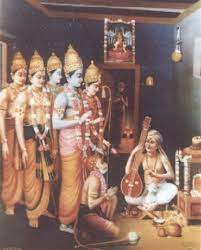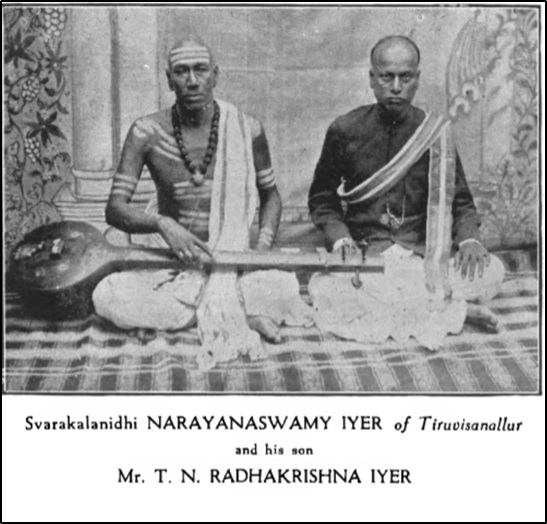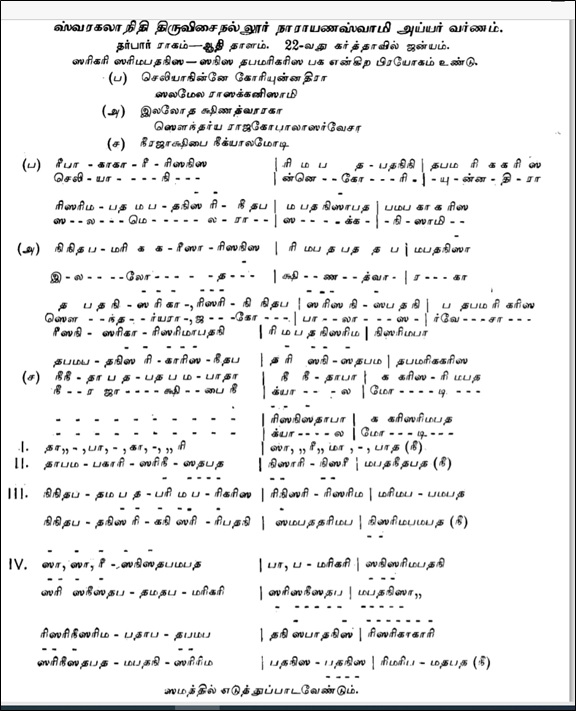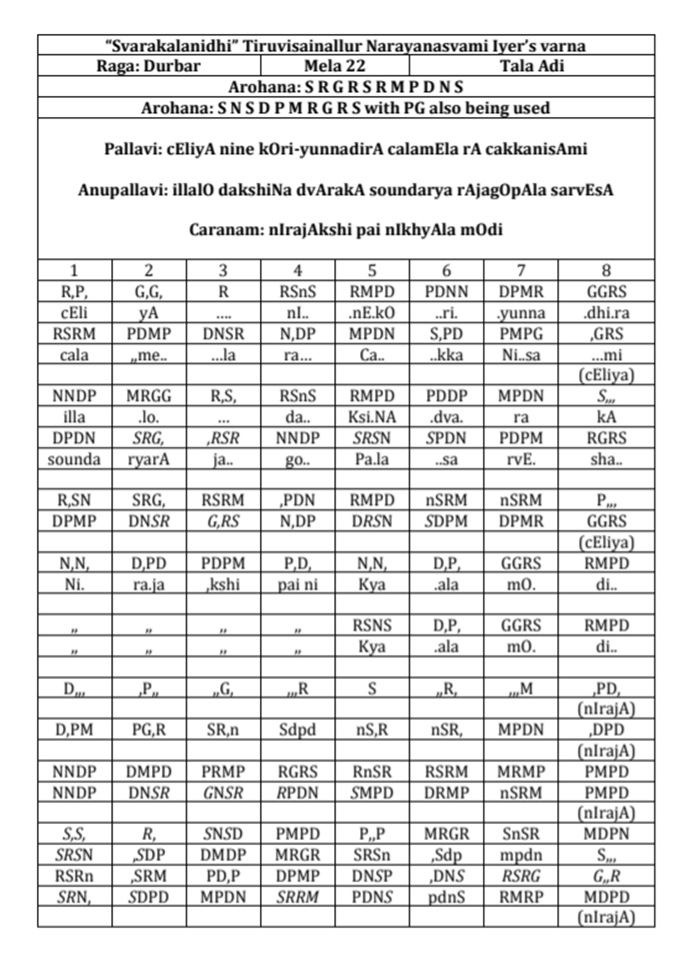[simple-author-box]
We get to know the structure of many rāga-s only through Saṅgīta Sampradāya Pradarṣini of Subbarāma Dīkṣitar. This text has both musical and musicological importance, as the rāga-s are not only explained by their phrases, but also through compositions. One such rāga whose svarūpa can be grasped well by analyzing this text is Gōpikāvasanta. A detailed analysis of this rāga has been done, wherein the author has concluded that Gōpikāvasanta is actually a name given to an old rāga by name Induganṭāravam. The conclusion was made based on the similarities between the two rāga-s and by considering the musicological treatises. Let us revisit this hypothesis in the light of some fresh evidences.
Gōpikāvasanta – Lakṣaṇa
Perhaps Subbarāma Dīkṣitar and Anubanda to Caturdanḍīprakāśikā attributed to Vēṅkaṭamakhi were the only teatises that describe this raga (See Footnote 1). Gōpikāvasanta is a bhāṣāṅga, vakra sampūrṇa janya of mēla 20 (Nārīrītigaula or Naṭabhairavi). He gives a śloka and mūrcana and few phrases to explain the rāga and then proceeds to give a kṛti of Muddusvāmi Dīkṣitar and his own sañcāri. We have mentioned in our post on Kamās that interpreting the mūrcana verbatim will not only lead to confusion, but also an incomplete understanding of a rāga and it is always to be combined with the notated compositions. Likewise, in this case we do find some discrepancies between the lakṣaṇa given in the śloka and the prayōga-s seen in the kṛti. Let us first look into the lakṣaṇa ślōka given in Pradarṣini:
syāt gōpikāvasantākhyaḥ pūrṇaṣṣaḍjagrahānvitaḥ I
ārōhē ca dhavakraśca avarōhē rivakritaḥ II
The gṛha of this sampūrṇa rāga is ṣaḍjam and the svara-s dhaivata and ṛṣbha are vakra in ārōhaṇa and avarōhaṇa respectively are the maximum possible details that can be gathered from this lakṣaṇa śloka.1 Mūrcana given by Dīkṣitar is RSRGMPDPNNS SNDPMGRMGS which gives a slightly clear picture. It can be observed that the possible phrase that lead us to tāra ṣaḍja is PNNS and to that of madya ṣaḍja is RMGS. More detail can be gathered by studying the salient phrases delineated by Dīkṣitar (See Footnote 2). By this exercise, few details not mentioned in the śloka and mūrcana can be learnt. Also we come to know the additional phrase to reach tāra ṣaḍja is PS. Similarly madya ṣaḍja can also be touched by the phrase RGS. There are special phrases like NDM and RM which is usually suffixed with RG or GS.
The above elucidation clearly shows the importance of reading the rāga as a whole rather than analyzing the mūrcana alone. Our learning further enhances and is completed when the kṛti-s in this rāga notated by Dīkṣitar are analyzed.
Gōpikāvasanta – Consensus
Gōpikāvasanta was taken up by a conclave of musicians in The Music Academy conference as a part of rāga lakṣaṇa discussion. A reference to the mūrcana given by Subbarāma Dīkṣitar has been made and an utsava sampradāya kīrtanam of Tyāgarāja Svāmigal was sung by Māṅgudi Cidambara Bgāgavatar. A consensus was made and this rāga was considered as a janya of mēla 20 with the presence of antara gāndhāra, catuśruti dhaivata and kākali niṣādha. This rāga followed the scale SRGMPNS SNDPMGS. This lead us nowhere and we don’t know whether that was a different rāga or a variant (aberrant form?) existed at that time.2
Kṛti-s in Gōpikāvasanta
There are two kṛti-s notated by Dīkṣitar in this rāga. The first one is the well-known ‘bālakṛṣṇam bhāvayāmi’ of Muddusvāmy Dīkṣitar and the second one is ‘gōvindarājam’, a very rare one by Kṛṣṇasvāmy Ayya. Subbarāma Dīkṣitar tuned the compositions of the latter composer and this is no exception. Though many of the compositions of Kṛṣṇasvāmy Ayya can be seen in Saṅgīta Sampradāya Pradarṣini, this composition is seen only in the lesser known and perhaps the last publication of Subbarāma Dīkṣitar ‘Samskṛta ānḍra drāviḍa kīrtanālu’ published in the year 1906 (See Footnote 3).3 There is supposed to be a kṛti of Tyāgarāja Svamigal in this rāga which will be taken up soon.
Bālakṛṣṇam bhāvayāmi of Muddusvāmy Dīkṣitar
This is a kṛti on Śrī Kṛṣṇa. No reference to any specific kṣetra is seen in this kṛti. As mentioned earlier, this has many prayōga-s, not mentioned in the mūrcana or in the specific phrases listed like PMPG, P(mandra sthāyi)R, SGR,SMMS and RGMGS. Analysis of this kṛti can be read in the article cited above.
Gōvindarājam of Kṛṣṇasvāmy Ayya – Subbarāma Dīkṣitar
Kṛṣṇasvāmy Ayya is an underrated composer who has composed many kṛti-s in Sanskrit, Tamiz and Telugu. It is much unfortunate that many of his kṛti-s are not presented on stage. Subbarāma Dīkṣitar’s musical inception can be studied by analyzing these tunes and are definitely useful in understanding the musical style of Dīkṣitar family. This kṛti is on Kṛṣṇa incarnated as Gōvindarājā.
This is set in pallavi-anupallavi-caraṇam format with a muktāyi svara at the end. Many of the key phrases seen in the kṛti ‘bālakṛṣṇam bhāvayāmi’ and the phrases elucidated while describing the rāga can be seen here. Even before we cross the first line of the sāhitya, the phrase P(mandra sthāyi)S is highlighted and this phrases repeats. Similarly, PS too recur often. We do see some new phrases like SRS, PNDNDM, and DNDDM. Phrases used by Muddusvāmy Dīkṣitar like RGMGS, SMMS are not seen here. Whereas the svara-s ṣaḍja and gāndhāra were used as gṛha svara by Muddusvāmy Dīkṣitar, it is pañcama and gāndhāra by Subbarāma Dīkṣitar. This kṛti by Subbarāma Dīkṣitar has many repetitive phrases like GRGS, DNDNDM and SPS which is not the case with the other kṛti. It is very clear that Subbarāma Dīkṣitar has tried to give us a very different picture of this rāga. It is to be remembered here that Muddusvāmy Dīkṣitar has extracted this rāga to its maximum possible limit without compromising the melody. Subbarāma Dīkṣitar, understanding this limitation and being aware of the restricted scope of this rāga has shown us the lesser exposed side of this rāga, thereby giving a different, yet complete picture. This kṛti also serves as an exemplar to understand Dīkṣitar’s musical acumen in the realm of tāla. This kṛti can be heard here.
Sañcāri of Subbarāma Dīkṣitar
In the treatise Saṅgīta Sampradāya Pradarṣini, whether a particular rāga is furnished with a kṛti or not, it invariably has a sañcāri composed by Subbarāma Dīkṣitar. Sañcāri in this rāga forms an important role as it is not just an encapsulation of the kṛti ‘bālakṛṣṇam bhāvayāmi’ or the phrases he elucidated while introducing this rāga. Neither is it a replica of the phrases seen in the kṛti ‘gōvindarājam’. It is unique in its own way as it gives us a more complete picture of this rāga. New phrases found here help us to understand this rāga further, which includes PDM,NS, SNS and GGPP. The phrase SPS is again stressed and also we get to see other phrases in mandra sthāyi like PR and NS (P and N are in mandra sthāyi).
From the above discussion it could be well perceived that Dīkṣitar has not explained all the phrases in his introductory remarks (to this rāga); mūrcana given by him is not comprehensive in explaining a rāga. When we see the phrases which cannot be redacted from the mūrcana and also when older forms like gīta or prabandha were not furnished (in his Pradarṣini), how and from where Dīkṣitar extracted these places?
Following hypotheses can be proposed:
- Dīkṣitar (Muddusvāmy and/or Subbarāma) could have had unpublished gīta-prabandha-s with them (See Footnote 4).
- Rāga lakṣana said to be written by Vēṅkaṭamakhi, which was in the possession of Subbarāma Dīkṣitar could have an explanatory phrases to understand rāga-s like this. The book what we call it as ‘anubandha’ appears to be an incomplete work. A lakṣaṇa granta tries to explain a rāga with its phrases or more detailed ślōka-s. The ślōka-s in the ‘anubandha’ are totally redundant in understanding a rāga and they more appear to be a part of a main treatise which is yet to be discovered.
Gōpikāvasanta and Indughanṭārava – Two names for a single rāga?
We have reiterated several times that the compositions handed over to us by oral tradition or through the printed texts and the rāga lakṣaṇa therein is not comprehensive in any manner. We need to look into unpublished manuscripts lying untouched at various repositories. Analysis without considering the data given in the manuscripts will be superfluous and will not give us an exact solution.
A manuscript in Tanjāvūr Mahārāja Śerfoji Sarasvati Mahāl Library (TMSSML)
TMSSML is a veritable source to understand the cultural history of Tanjāvūr as it preserves manuscripts related to our culture and many of them are yet to be explored. Many of these manuscripts are believed to be of Nāyak period.3 One among this is a manuscript having a collection of gīta-s and sūlādi-s in notation. This manuscript also has a notation for āyittam in the rāga Gōpikāvasanta (See Footnote 5). Gōpikāvasanta is also mentioned as (a janya of) Bhairavi mēla. This shows the existence of this rāga during or even before the period of Śāhāji and Tulaja. The phrases there in, though much less elaborative that what is seen in the compositions mentioned above, is much suggestive of Gōpikāvasanta. Excluding two phrases, other prayōga-s can be seen in the compositions mentioned above. The unique prayōga-s seen only in this āyittam are GRS and PDNS! How can we reconcile this? This rāga also has the phrases PDND (also seen in the āyittam) and SNS.
Technically, this rāga could have had these phrases (GRS and PDNS) and these composers could have avoided using this phrase. Not necessarily, a composer is expected to exhaust all the phrases in his composition. Secondly, Dīkṣitar has mentioned several phrases in many rāga-s that they are used only in gīta-s or prabandha-s and not in kīrtana-s. Even in this case, Dīkṣitar remarks, the phrase PNS or SNS is seen only in the tānam. GRS and PDNS could have been such unique phrases used only in those genres and not used in kṛti-s.
An old rāga
Based on these evidences, we can clearly say this is definitely an old rāga, existent even before the time of Muddusvāmy Dīkṣitar and due to some unknown reasons, was not catalogued in the treatises like Rāga lakṣaṇamu of Śahāji or Saṅgīta Sāramṛta of Tulaja. Having said this, we will now analyze Indughaṇṭārava and see how it differs from Gōpikāvasanta.
Indughaṇṭārava – Lakṣaṇa
This is a janya of Bhairavi mēla says Śahāji and Tulaja. This could correspond to Nārīrītigaula mentioned by Subbarāma Dīkṣitar. They have given some illustrative phrases and stressed PDNS and MGRS will not occur in this rāga.5
Though it appears much similar to Gōpikāvasanta, certain vital differences can be seen on careful introspection of the phrases given by them. First is the appearance of the phrases PDNS and GRS. This cannot occur in Indughaṇṭārava, but seen in Gōpikāvasanta. Second is the phrase SRGMGS. This is seen only in Indughaṇṭārava and not in the āyittam or any of the available compositions in Gōpikāvasanta. The common avarōhaṇa phrase in Indughaṇṭārava is SNDPM, which is certainly not permissible in Gōpikāvasanta (See Footnote 6).
Based on the available evidences, we can clearly conclude both are old rāga-s and are much allied to each other. We had many gīta-s and tāna-s in both these rāga-s, implying both could have been popular. As mentioned earlier, due to some unknown reasons, some musicologists failed to catalogue Gōpikāvasanta (See Footnote 7). We get to know Indughaṇṭārava is a ghana and naya rāga. Can Gōpikāvasanta be a dēśīya rāga and hence got missed to be catalogued like many other dēśīya rāga-s?
A kṛti of Tyāgarāja Svāmigal
We have mentioned about Māṅgudi Cidambara Bāgavatar singing an utsava sampradāya in the rāga Gōpikāvasanta. Though we have no clue on the kṛti, we can narrow down our search based on an information given by Taccur brothers.
Taccur brothers had published a series of books in the earlier part of the last century. One among them is Śrī Bhagavad Sārāmṛtam, published in the year 1916.6 This has a kṛti of Svāmigal in the rāgaṃ Gōpikāvasanta.
Śri rāma rāma rāma is an utsava sampradāya kṛti, now sung in Nīlāmbari. Almost all the texts mention the rāga of this kṛti as Nīlāmbari, but mentioned as Gōpikāvasanta by Taccur brothers. Another significant observation here is the tāla of this kṛti is not specified. It should be sung like an ālāpana, without reckoning tāla says the author. We were unable to find any living tradition singing this kṛti like this.
The melody of this sounds much different from the Gōpikāvasanta that we were discussing. Many phrases like PMR and RGMDP, which are not seen in the compositions mentioned earlier can be seen. The svarūpa seen here does not even seem to match the scale given by them (in the ‘rāga lakṣaṇa proceedings’ happened in The Music Academy); Gōpikāvasanta mentioned by them is devoid of ṛṣbham, but this version has. Combining these evidences with the points mentioned in The Music Academy conference, this could have been some other rāga disguised in the name of Gōpikāvasanta.
Conclusion
Based on the presently available evidences, we can conclude Gōpikāvasanta was a separate entity from Indughaṇṭārava though they share very many similarities. Many rāga-s have not been catalogued by the lakṣaṇa granthakāra-s and it is only by examination of gīta-prabandha manuscripts preserved at various repositories and texts like Saṅgīta Sampradāya Pradarṣini we get to know the mere existence of these rāga-s. The Dīkṣitar family had done a great service by providing these abstract rāga-s in the form of kṛti-s which are more palatable than any other form and we are indebted to Subbarāma Dīkṣitar for cataloguing rāga-s like Gōpikāvasanta which do not have any textual reference. This also shows Dīkṣitar was much aware of his tradition and assiduously bequeathed to us.
Acknowledgement
I thank Dr Ārati Rao, Research Scholar for providing me a copy of TMSSML manuscript.
References
1. Subbarāma Dīkṣitulu. 1904. Saṅgīta Sampradāya Pradarṣini, Vidyā Vilāsini Press, Eṭṭayapuraṃ Samasthānaṃ.
2. Proceedings of the Experts Committee of the Madras Music Academy. 1938. The Journal of Music Academy, Volume IX, p 17-18.
3. Subbarāma Dīkṣitulu. 1906. Samskṛta ānḍra drāviḍa kīrtanālu. Eṭṭayyapuram Vidyā Vilāsini Mudrākṣaraśala, p 42-43.
4. Sīta, S. 1976. Dīkṣitar and Vēṅkaṭamakhin’s tradition. The Journal of Music Academy, p 129.
5. Hema Ramanathan. 2004. Ragalakshana Sangraha – Collection of Raga Descriptions, p 565-567.
6. Taccur Śingarācāryulu, Cinna Śankarācāryulu. 1916. Gāyaka siddhāṅjanamu. Cennapuri Śaśilēkhā Mudrākśaraśālā, p 45-46.
Footnotes
Footnote 1
Saṅgraha Cūḍāmaṇi and its allied texts do make a note of this rāga. But the scale given there lacks ṛṣbham completely and is much different from the Gōpikāvasanta described here.
Footnote 2
RgmrG, RmrG, Rggs, RgM, PdpM, GmP, rgmP, ndM, grmgS, rmrgS, PsPPs, GRmgS, Pnns, psns were few of the phrases mentioned by Dīkṣitar (P is in mandra sthāyi).
Footnote 3
Raṅga Rāmānuja Ayyaṅgār has notated this composition in his book ‘kṛti maṇi mālai’. We find a completely different version there. This version is not taken for comparison, as we have an authentic version given by the composer himself and the version by Ayyaṅgār is definitely a retuned one irrespective of his source. The tāla intricacies seen in the composer’s version is not maintained here and this version also lacks the citta svaram.
Footnote 4
Dīkṣitar, at many places in Pradarṣini proclaims he has supplementary material in the form of tāna-s and gīta-s and not publishing them because of space restraint. One such example that might be of relevance here is the note that he gives in the Ābhērī rāga lakṣana. He clearly mentions he has tāna-s to support the statement given by him regarding the lakṣaṇa and not publishing them. For the same reason, he could have refrained himself from publishing tāna-s in the rāga Gōpikāvasanta.
Footnote 5
Rāga ālāpana was also referred as ‘āyitam’.
Footnote 6
It is to be accepted that the phrases available to us are very limited and we need to see the compositions in full to understand the rāga Indughaṇṭārava.
Footnote 7
In this regard, Gōpikāvasanta alone is not a solitary exclusion. Many dēśi rāga-s like Bhairavam, Aṭhāṇa, Bēgaḍa etc., were not catalogued by Śāhāji and Tulaja.






